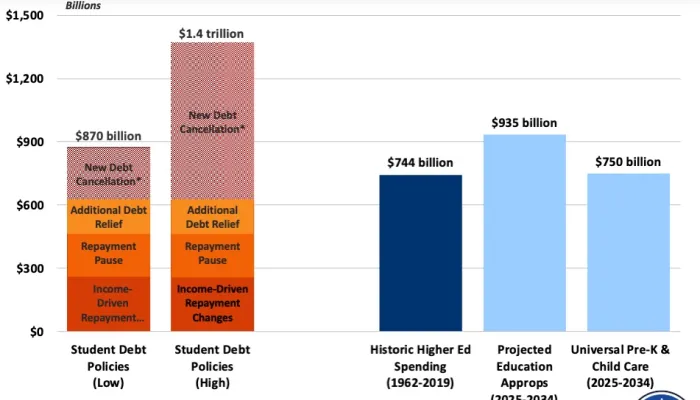What's In the Bipartisan Infrastructure Plan?
UPDATE 8/5: We have published a new summary of the bipartisan Infrastructure Investment and Jobs Act based on a recently published score from the Congressional Budget Office.
UPDATE 7/29: A bipartisan group of senators announced they had reached a deal on an infrastructure spending package – the Bipartisan Infrastructure Investment and Jobs Act – that would add nearly $550 billion in new spending. We have published a summary of that package here.
A bipartisan group of 20 senators have apparently agreed to a new infrastructure framework to increase infrastructure spending by $579 billion over ten years. According to a leaked fact sheet, the plan includes $312 billion of transportation infrastructure – with about one-third going to roads and bridges and one-third to rail and public transit – along with $266 billion of other infrastructure in areas like power, broadband, and water. (UPDATE 6/24 and 6/15: This blog has been updated from its original version to reflect new details).
The agreement would cost about a quarter as much as President Joe Biden's proposed $2.6 trillion American Jobs Plan, both because it excludes spending not related to so-called "core infrastructure" and because it spends less in most of the areas the two plans have in common.
The $579 billion of spending in the bipartisan plan is two-thirds as large as the $904 billion of "core infrastructure" in the American Jobs Plan. Nearly half of the difference is due to much lower spending on electric vehicles in the bipartisan plan. Other areas where it spends significantly less include roads, bridges, and other major projects; water infrastructure; broadband infrastructure; and projects to reconnect neighborhoods.
The American Jobs Plan also spends $1.7 trillion more in areas outside of core infrastructure not addressed in the bipartisan plan. This includes $400 billion for home- and community-based services for long-term care; $424 billion for tax credits largely for clean energy; $326 billion for housing, school, and building improvements; and $566 billion for research and development (R&D), manufacturing, and other spending.
| Spending Area | American Jobs Plan | Infrastructure Agreement |
|---|---|---|
| Roads, bridges, and major projects | $154 billion | $109 billion |
| Passenger and freight rail | $74 billion | $66 billion |
| Public transit | $77 billion | $49 billion |
| Airports | $25 billion | $25 billion |
| Infrastructure financing authority | N/A | $20 billion |
| Ports and waterways | $17 billion | $16 billion |
| Electric vehicles | $157 billion | $15 billion |
| Road safety | $19 billion | $11 billion |
| Reconnecting communities | $24 billion | $1 billion |
| Subtotal, Transportation Infrastructure | $546 billion | $312 billion |
| Power infrastructure | $82 billion | $73 billion |
| Broadband | $100 billion | $65 billion |
| Water infrastructure (including lead pipes) | $111 billion | $55 billion |
| Resiliency | $47 billion | $47 billion |
| Orphan wells/abandoned mines | $16 billion | $16 billion |
| Superfund | N/A | $5 billion |
| Western water storage | $3 billion | $5 billion |
| Subtotal, Other Core Infrastructure | $358 billion | $266 billion |
| Total, Common Areas | $904 billion | $579 billion |
| Long-term care (home- and community-based services) | $400 billion | N/A |
| Tax credits (mostly clean energy) | $424 billion | N/A |
| Housing, schools, and buildings | $326 billion | N/A |
| R&D, manufacturing, and other spending | $566 billion | N/A |
| Subtotal, Additional Spending | $1.7 trillion | N/A |
| Total | $2.6 trillion | $579 billion |
Sources: Office of Management and Budget, media reports. Numbers may not sum due to rounding.
To help pay new spending, lawmakers have agreed to a number of offsets to reduce the tax gap, impose or extend various fees, repurpose COVID relief funds, and make or count savings from other changes. In a future analysis, we will attempt to assess and estimate the impact of these assumed offsets. The below table reflects offsets as presented by the negotiators, based on reporting from Lisa Desjardins of PBS NewsHour.
| Offset | Ten-Year Savings |
|---|---|
| Increase IRS funding to reduce the tax gap | $100 billion |
| Increase UI program integrity funding to reduce unemployment fraud | $72 billion |
| Spectrum Auctions | $65 billion |
| Reinstate Superfund fee on chemicals | $13 billion |
| Extend Medicare sequester | $9 billion |
| Extend expiring customs user fees | $6 billion |
| Sell oil from the Strategic Petroleum Reserve | $6 billion |
| Use alternative financing mechanisms like public-private partnerships and direct pay municipal bonds to fund infrastructure | $100 billion |
| Repurpose some COVID relief funds for infrastructure | $80 billion |
| Allow states to sell unused toll credits to finance infrastructure | $30 billion |
| Count unused unemployment funds from states that terminated benefits early | $25 billion |
| Repurpose existing broadband funding | $20 billion |
| Count expected dynamic feedback from increased economic growth from package | $58 billion |
| Total | $584 billion |
Source: PBS NewsHour


